Inner-city American experience holds numerous tenets rife with possibility for interpretation. For over a decade, Ian Weaver has explored the history and memories of Chicago’s African-American community in a series of thoughtful and provocative works. I was first introduced to Weaver while living over on 18th Street. His honest voice piqued my interest. And, my wife and I commissioned him to produce a portrait. This painting now hangs in our bedroom. Recently, I caught up with Weaver at the Chicago Cultural Center for a chat at his opening of his solo exhibition The Black Knights’ Archive.
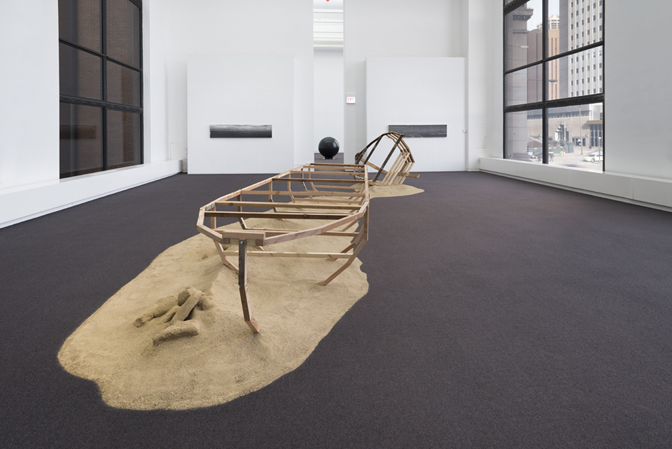
Ian Weaver, MIGRATION OVERVIEW, 2015
Foreground: “FLEET”, 2015, wood, rope, various dimensions
Middle ground: “SHORELINE” works.
Background: “GLOBE”, 2015, Aluminum, enamel, 47” diameter
You grew up in Chicago. I believe we first met over a decade ago when you and I lived in Pilsen. Can we start with a little background? Perhaps you can share any life experiences or influences that have informed your artistic practice?
I grew up on the far southeast side of Chicago. I didn’t have a real formal art training growing up; I drew pictures from newspaper comic strips and my collection of comic books and graphic novels. I’ve always been interested in a narrative structure.
My mother and her siblings grew up in the Maxwell Street area of the Near West Side, however, in the 1940s and 50s. That is where I have drawn my inspiration for the body of work I am currently working with.
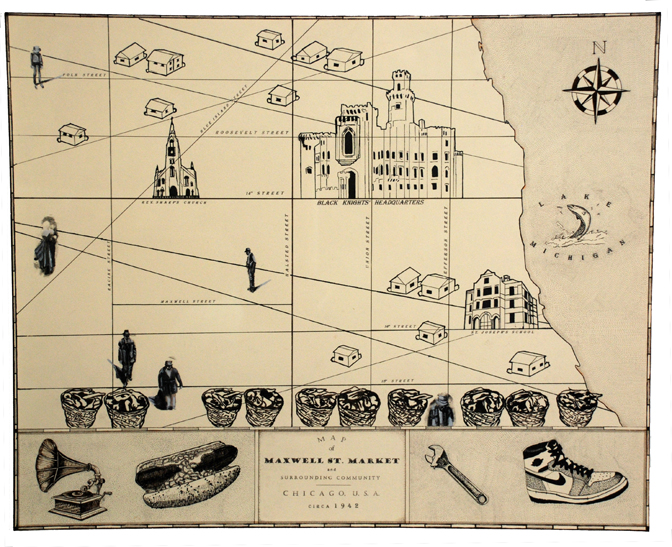
Ian Weaver, MAP OF MAXWELL STREET AND SURROUNDING COMMUNITY, 2010
Acrylic ink and transfer on paper
27″ x 22 ¼”
Your Black Knights’ Archive is on view until April 19, 2015 at the Chicago Cultural Center. This is a fictive construction of the history of the Near West Side Chicago neighborhood known as “Black Bottom”. Can you walk us through this project? What was the impetus for initiating this body of work? What role does nostalgia, collective memory and power play?
My work – which is informed by the concepts of history, memory, and mythology, as well as anthropology and ethnography – is also interdisciplinary in structure, utilizing a variety of media (such as drawing/collage, assemblage, sculpture, installation and film) which act as metaphors for “fracture”. I am interested in how we – as individuals and communities – construct our own identities and memories; we do this through our commemorations and the objects we construct and archive.
Overall, the work speaks to the concept that Memory is fractured, non-linear, and disparate in nature; the experience of “recall” is a dissociative one. I want the viewer to question the constructions we routinely undertake throughout our lives.
Specifically, my current project centers on the Near West Side of Chicago. The “Maxwell Street” area of the Near West Side was a vibrant, integrated immigrant community. During the late 1950s and throughout the 1960s, however, Chicago embarked upon the construction of an elaborate expressway system that would cut across the city. The city acquired land for the system by moving poor families from their homes, and razing a variety of buildings. My mother, who grew up in the “Black Bottom” section of the neighborhood, lost the home in which she was raised, the park at which she played, and the school she attended. My grandfather lost his church and store. In a relatively short period of time, our family lost a great deal of its history.
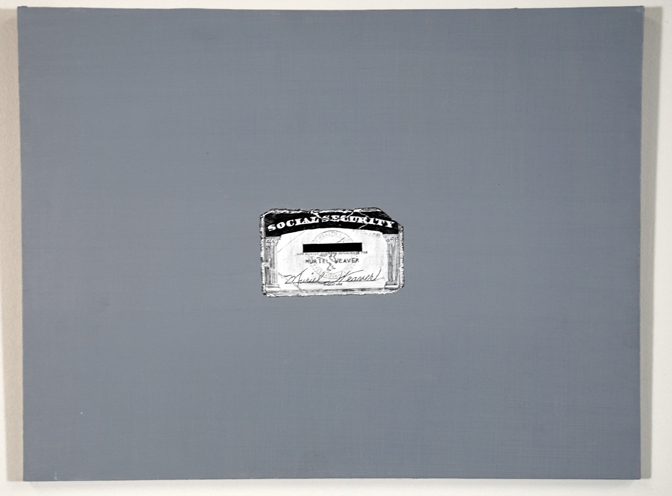
Ian Weaver, REDACTED, 2006
Oil on Panel
11 ½” x 14”
My initial attempt, then, had been to piece together the remaining historical information to reclaim this history. My journey began with my mother. I began to receive various documents from my mother that represented the material information of her siblings’ and parents’ existence: birth and death certificates, a marriage license and a divorce decree, a personal letter, and several photographs. The information was so disparate that it immediately caused me to conceive of the series in a collage-like format (both literally and figuratively). With the documents, I wanted to create paintings that faithfully, and in a deliberate manner, recorded the factual information of my family’s past. The style I chose for this project was the “trompe l’oeil”, or “trick the eye” style of realist painting. I wanted the execution of the works to be about the work, not about my facility in handling the paint surface, although some of the painterly style does surface in a few of the works. I saw myself as being a facilitator of this series, more archivist than artist.
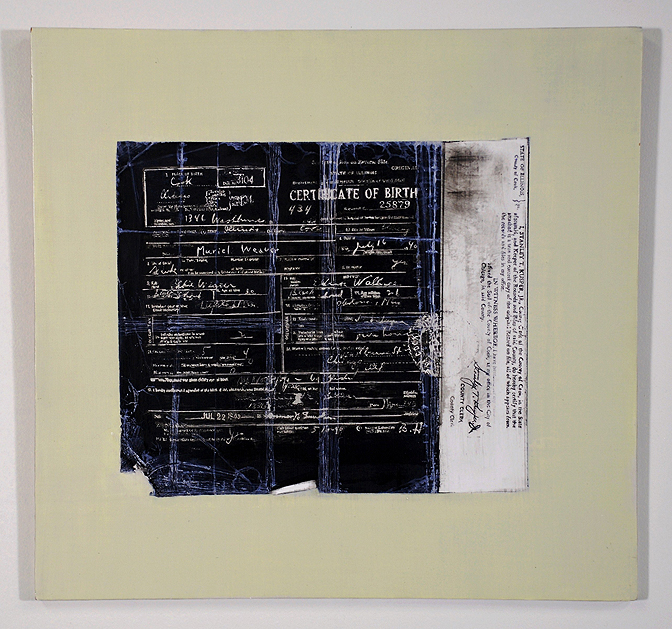
Ian Weaver, BIRTH, 2004-05
Oil on Panel
13 ½” x 14”
This archivist impulse led me, In May, 2008, to create a fictional history museum (housed within the Kemper Art Museum, St Louis, MO) which told the history of the Black Bottom community, circa 1940s. Since a great deal of this community’s history was lost, I decided to construct my own history for it. All of the items (faux maps, sculptures, vitrines, etc) were meant to give the impression of visiting a history museum, albeit a very scattered, non-linear one. This work also incorporated mapmaking as a parallel to the history of the area. The maps are completely fictional, but reference the actual community. The use of maps suggests the geographic changes that occurred in the community. Maps also have an established history; placing the “Black Bottom” community within this established history bolsters the history of the community itself.
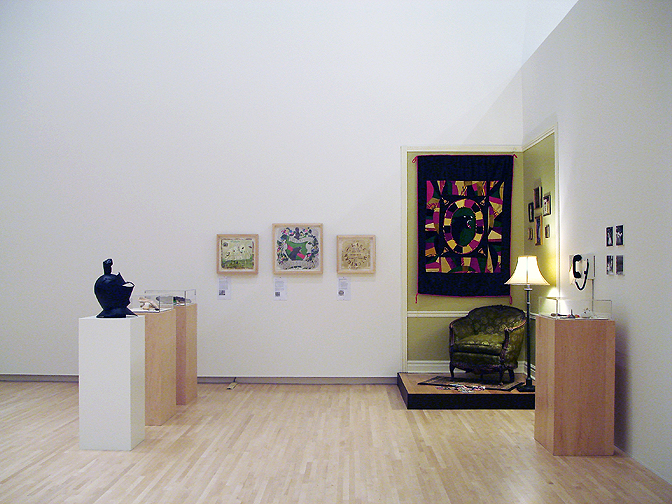
Ian Weaver, BLACK BOTTOM HISTORY MUSEUM, 2008
Mixed-media installation, various dimensions
Installed at Mildred Lane Kemper Art Museum, St Louis, MO
(May, 2008)
Lately, however, I have wanted to the series to be more open, and to speak more metaphorically about the issues I am interested in (construction of memory, history, identity) by using the community rather than speaking directly about the community. This current series is an example, in that I make references to the Black Bottom but not specifically in the made works (only in the didactic materials). I want people to come in and have an aesthetic experience first, then come back to the content. I’m more interested in the formal aspects now than ever before.
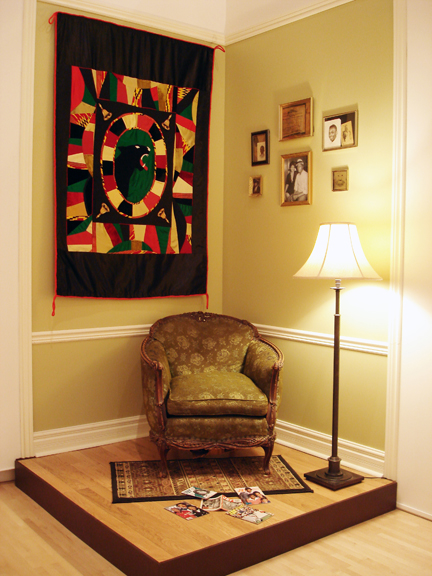
Ian Weaver, A TYPICAL BLACK BOTTOM HOME, 2008
Mixed-media installation
Overall dimensions: 120” x 60” x 60”
Nostalgia is important to me insofar as it was a motivation for initially making the work. I had a “nostalgic impulse” in that I had notions of what the lost history should be, what form it would take on (letters and documents, found artifacts, old films). But, these are fake. My impulse was misguided. I never wanted to make nostalgic work in the way most people would describe nostalgia, like a reminiscence of things past. I wanted to make works that seemed nostalgic but could never be because they never existed.
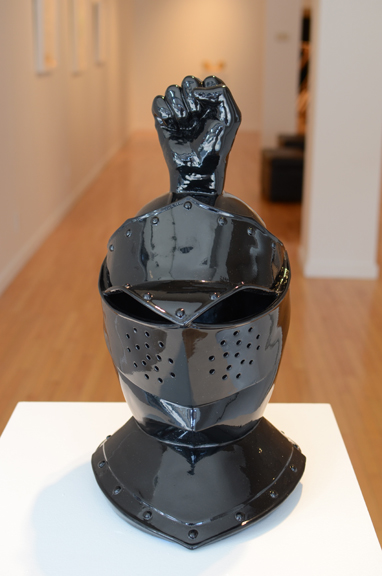
Ian Weaver, BLACK POWER HELMET, 2009
Aluminum
18” x 9” x 12”
Can you describe the role of research in your art practice? You look at a variety of areas, including African-American and European history, anthropology, ethnography, and museology. Is there any blurring of the lines in historical interpretation?
I research a variety of sources, but they don’t all find their way into the final works. The biggest influence is Memory Studies, a large field that moves between the Humanities and into the visual arts. Memory touches all of these other areas of interest: archives, history (of course), ethnography, etc. It is probably the one academic field I have spent the most time studying. In terms of blurring lines, I think the entire project is about blurring. I want there to be some fact and fiction in the retelling of these narratives. I am hoping the viewer will see that as a metaphor for the blurring of memory, of not knowing what is real and what we manufacture in the name of “nostalgia”.

Ian Weaver, SHORELINE I, 2014
Emulsion transfer with sanding and wax on panel
9.5″ x 96″
In addition to being a practicing artist you are currently teaching at St. Mary’s College. What items do you believe are important in passing on to your students?
I think there is a funny thing about the arts: the older you get, generally speaking, the less conservative you become in your practice. Maybe it is the fear that there is so little time left to make your work, or maybe it is that as we age we realize what is most meaningful and want to spend as much time as possible doing that. But, it is a trend I have noticed. So, the other side of this trend is that younger artists (including students) tend to be very conservative. They don’t want to “mess things up”, and I don’t just mean technically, but even in terms of research and brainstorming. They don’t want to chance that they might not come up with a better idea, so when we have assignments that are content-driven they tend to stick with their first brainstorm ideas. They are also too assessment-driven, but that is a function of the larger society (certainly the larger academic society, not just in the arts).
My goal is to get them to stop doing all of that! I usually tell my students that I won’t answer most of their aesthetic questions, because I don’t want to make their work for them. I want to give them the best technical information possible, because having as many tools in your tool chest as possible is one of the most important aspects of being an artist. I want them to be problem-solvers. Most of my students (from when I was at SAIC or now at Saint Mary’s College) won’t continue on to become professional practicing artists, only because statistically most art grads don’t continue to make their work. I think the official statistic is less than 10% are making art 5 years after graduation. So, I want them to see that, essentially, all we are doing is problem-solving, which is important no matter what you go on to do (I hope they continue on to be artists, though!) If things don’t work in my studio, or the materials I needed don’t arrive or are wrong in some way, I have to figure out another way to make things work. Artwork isn’t about waiting for muses to spur you on by whispering inspiration in your ear. It’s about the regular practice of making work and failing a lot of the time, and solving problems, like in a laboratory.
That’s what I’d like them to take away from my courses: that they should amass as much technical information as possible, use it in whatever way is meaningful to them, and become very intimate with failure.
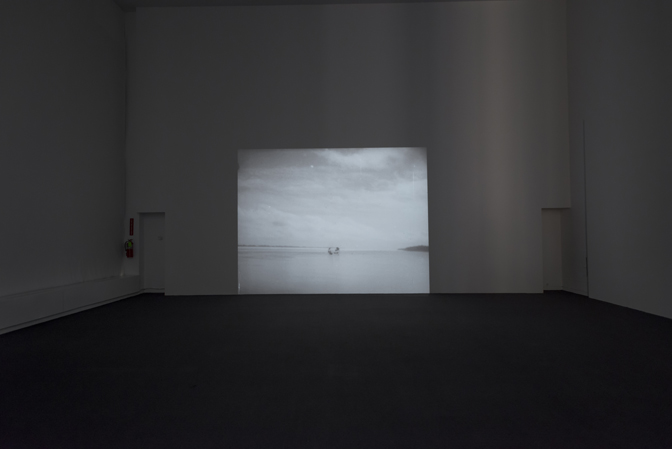
Ian Weaver, MIGRATION, 2014
Still from film
16mm film to digital transfer
Running time: 1:31
This has been a rather busy period for you. What are you planning next? Do you have any works underway or upcoming exhibitions?
In the last year I have applied to and interviewed for various teaching jobs, packed up my apartment and studio and moved out of state, and become acquainted with a new institution, all while making new work for two solo shows that happened in August (at the Indianapolis Museum of Contemporary Art) and January (here at the Cultural Center). So, no new shows upcoming! Exhibiting is a lot of work, and to do two solos in the midst of all that is really draining. Right now, I am applying for grants and residencies, the business-side of things that has to happen, and getting ready for this spring/summer period to make more work.
This series is just starting, which is where the “Chapter” in the title comes in. I am really thinking about it unfolding the way a novel does, albeit in a non-linear way. I have some other works I’d like to make to round out the “Migration” chapter, then think about what’s next. I haven’t planned out each chapter. I want to stay away from it feeling too structured.

Ian Weaver, SHORELINE IV, 2014
Emulsion transfer with sanding and wax on panel
9.5″ x 96″
Additional information on the work of Ian Weaver can be found at:
Ian Weaver at the Indianapolis Museum of Contemporary Art:
http://www.indymoca.org/2014/07/ian-weavers-the-black-knight-archive-chapter-1-migration/
Ian Weaver at the Chicago Cultural Center:
http://www.cityofchicago.org/city/en/depts/dca/supp_info/weaver.html
Ian Weaver Nuvo News Review:
http://www.nuvo.net/indianapolis/black-knight-archive-an-alternate-history-of-chicagos-south-side/Content?oid=2885140
Interview by Chester Alamo-Costello


